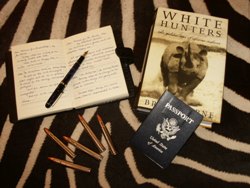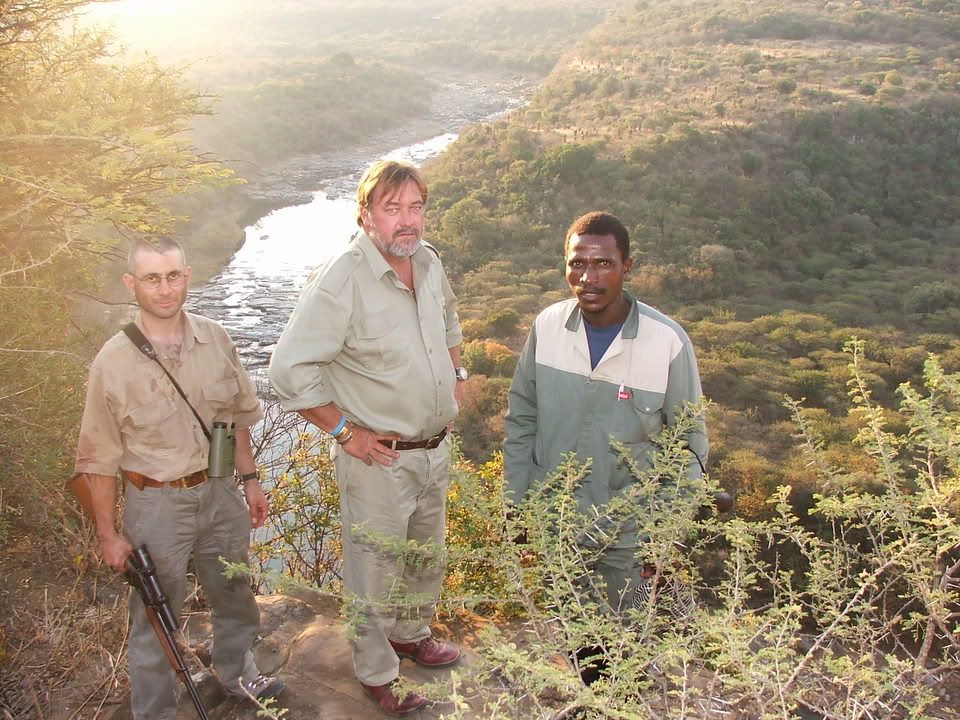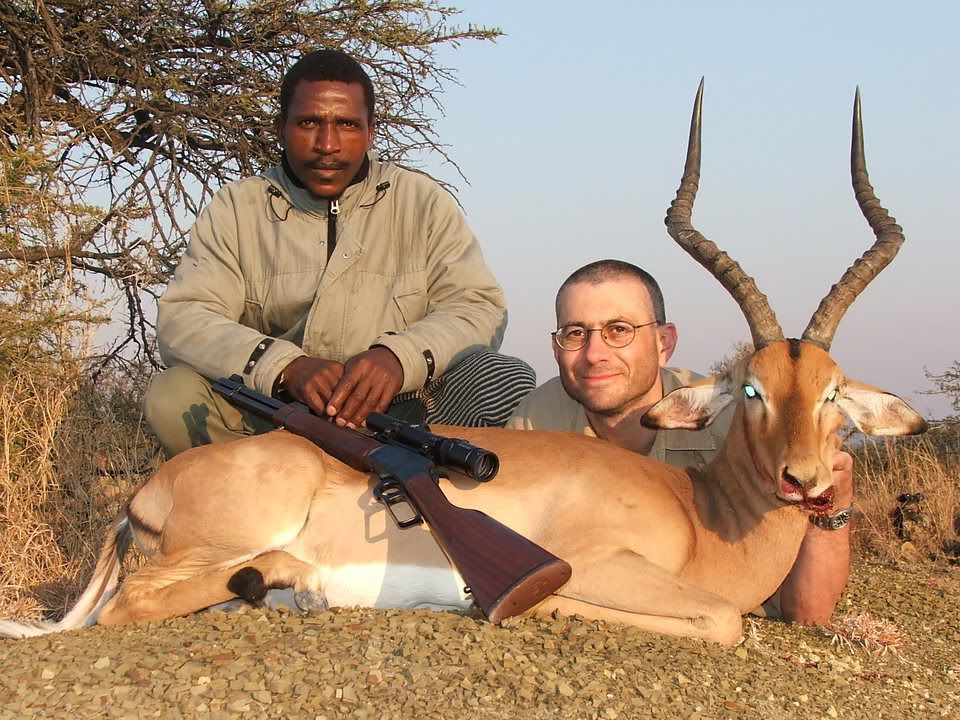

 The Accurate Reloading Forums
The Accurate Reloading Forums  THE ACCURATE RELOADING.COM FORUMS
THE ACCURATE RELOADING.COM FORUMS  Hunting
Hunting  Hunting Reports - Africa
Hunting Reports - Africa  357 Magnum Safari with Rifle and Reel Africa Safaris
357 Magnum Safari with Rifle and Reel Africa SafarisGo  | New  | Find  | Notify  | Tools  | Reply  |  |
| One of Us |
Written by long time client of Rifle and Reel Africa Safaris - Andy Law, the article below describes his hunt with a Marlin Levergun in Northern Kwa Zulu Natal during July this year. Date: July 2005 Area: Weenen - Northern Kwa Zulu Natal, South Africa Outfitter: Rifle and Reel Africa Safaris (Chris Troskie & Les Brett) Rating: Excellent  I slipped on a warm jacket, just as the sky was diluting to a dull metal grey. The sun would soon rise into the sky; dawn does not last for long in South Africa. However, in the upper regions of Kwa-Zulu Natal in the East of the country the temperature would remain cool for a little while yet. Cupping a mug of hot coffee, I reflected on the previous days’ hunting, and silently hoped for success today. Finishing it with a last gulp I picked up my Marlin 1894C lever action carbine in .357 Magnum and headed out to meet Professional Hunter Chris Troskie of Rifle and Reel Africa Safaris, who was guiding me on today’s hunt. The air has a thick feel to it at that time in the morning, but with a pleasing fresh smell one finds at dawn, and learns to enjoy before the sun burns off the moisture. I greeted Chris who was already organising the pickup truck, called a bakkie (pronounced “buckee†in Afrikaans) then turned away, and pointing the Marlin in a safe direction quickly thumbed half a dozen 357 158g’s into the magazine. I climbed onto the back of the 4X4 and placed the Marlin into the rubber coated gun rack behind the cab. Welcoming the Zulu tracker who would accompany us, I gripped the roll bar as Chris engaged gear and moved off. The hunting had started. I had hunted in South Africa many times previously, shooting plains game – zebra, kudu, wildebeest and so on with my Ruger No1 in .375 H&H magnum, which is in my opinion the best all rounder calibre for Africa. It was Chris’ associate in Rifle And Reel, Les Brett who had suggested that I could hunt smaller sized game with my 357 lever action, and after consideration I had welcomed the challenge. That was a couple of years ago. It was agreed that this year we would hunt in the hilly area of Northern Kwa Zulu Natal, which in parts is covered in thick bush. The game reserve was near the historic Tugela River, and was absolutely beautiful. We would be the only hunters on a farm thousands of acres in size. In Africa, as a result of European colonial action during the 19th Century, the bolt action rifle rules. In the USA the story was different of course, when pioneers utilised the lever gun. However, the lever action rifle has unique characteristics. It is very slim and compact. Point of balance falls plum centre on the receiver making it quick to handle. The drop of the heel on the butt is more pronounced than most bolt action rifles enabling the lever gun easier to shoot with off hand, kneeling or standing, as a couple of warthogs had found out during those hunts last year. The short 36-inch length is ideal for moving and manoeuvring in thick bush. As the saying goes you can load the lever action on Sunday and shoot all week. Well at just a few pounds in weight, you can carry it all week as well…. The Toyota drove slowly along the rutted track, as the tracker and I scanned the surrounding bush for game. The tracker had worked on the reserve for some years and possessed a sort of game radar or so it seemed to me. He also knew where the impala would be, occupying as they do a home range. Presently he tapped on the cab roof. Chris killed the engine and we stopped. Dropping to the ground the tracker indicated that we should follow. I lifted my Marlin from the rack and turning my back to the others, cycled the action. Setting the safety, then I lowered the hammer to half cock. As the bush appeared quite close, I removed the sling’s swivels from the QD studs to prevent the sling from snagging. Once ready we quietly headed into the bush. The veld (pronounced “feltâ€) is a mixture of knee height grass punctuated by bush and trees. Walking in Indian file we moved cautiously through the veld looking through the cover for sign of game, but using the bush as cover to conceal our own progression as best as possible. I walked behind the tracker so I would be in immediate position to shoot if required and in front of Chris who would be in position to advise me on a shot. The job of the PH is to guide the client into a position where he can take a shot at a good representative trophy animal, and to ensure the client does not shoot the wrong thing or to do something untoward. However, the final decision to fire always rests with the client. Often we would cross game paths, with spoor (track marks), sometimes with dung droppings. There clearly was a lot of game here. Then the tracker stopped, frozen, as immobile as a rock. He pointed slightly to the right. I looked and saw a blend of greens, ochre, yellow grass, with grey-brown of tree trunks, a smudge of red, green leaves, black shadow – a smudge of red. “Impala†Chris whispered. I nodded in recognition. Cross safety on, I snicked the hammer to full cock. Impala Aepyceros melampus melampus are a common antelope in South Africa, and are stunningly beautiful. Graceful and lithe, they possess a rich red coat turning abruptly to white at the under parts. The white rump is bordered with a black stripe each side. Only the males (rams) have horns, a wonderful ridged lyre shape sweeping up, back, then up and inwards once more. The rams and ewes are gregarious often in herds of 50 plus, with a dominant ram. Other rams form bachelor herds. The animal can be a delightful challenge to stalk, as being a herd animal there seems always one to be looking and listening for the approach of a predator. At a time of danger the impala will give an intense dry sneeze as an alarm then when the danger is felt strongly enough the herd will suddenly explode into all directions, the animals seemingly to leap with the skill of a ballet dancer; impala can jump up to 30ft, and 9ft high if sufficiently motivated. One of the impala seen was an impressive ram, part of a bachelor herd of some several rams. Instinctively we adopted a low crouch, and began to stalk carefully towards the ram, lifting each foot slowly and lowering it to the ground, “feeling†the ground underneath before settling the foot. I could already feel the moisture abandoning my mouth, seemingly to sink to my hands, which were now sweating. I gripped the stock a little tighter and moved on. Suddenly – a wheezing snort. The impala ram, now no more than 100 yards or so was looking straight at us. We had clearly been clocked. The wind was still in our favour, so he must have seen us. It can only have been our slow approach, which had prevented him from running immediately on his suspicion. We settled behind an acacia tree and pondered on how to proceed. Somehow the gap had to be closed. Between us was slight undulating ground covered in grass, but mostly devoid of tall cover. The impala were standing on the edge of a small pan, warming up in the early sun. Any movement as a party would be impossible without spooking the now alert herd. Chris made the decision, and said “Andy, try and leopard crawl closer and get a shot in if you can. We will remain here but in sight of youâ€. Having close stalked deer back home in such a manner, this was quite a reasonable solution. Gripping the fore stock of the Marlin with my left hand, the pistol grip cupped in the palm of my right hand with my thumb through the lever, I propelled myself forward by the elbows and toes - literally inching towards the impala… A high - pitched snort cracks the air, stinging my ears. I freeze, lowering my head a fraction but I must look. I must. I look up. The big impala has moved off, but there are two others standing face on, their eyes seemingly to pierce my skull, yet they surely are looking behind me. Then one moved slightly, a couple of steps. They are not certain, they are doubtful that is all. I am a hunter, I am a hunter. I inch forward once more. A thousand years later it seems, I reach a small rise at the edge of the pan. Screened by a few grasses I can see the two impala still standing square on looking. Another alarm snort slaps my ears. The impala are moving a little more restlessly now. They clearly are unhappy in their uneasiness, and one by one start to slip away further into the pan. There is less cover there, only isolated bushes and odd patches of grass and I sense that this particular stalk will be over, my opportunity evaporating like the morning’s mist. The last impala is moving away. Then in desperation as a last chance, I loudly cluck my tongue several times on the roof of my mouth - nothing to lose after all. Amazingly one turns back, and returns to stand near his previous position, perhaps for a final look. The ram is standing left side on, just ever so slightly quartering. My cross hair is imprinted on his red flank just behind the shoulder. My eye is being sucked into the scope, the lens is like a vortex, only the cross hair is there. Chris said afterwards that he distinctly heard the smack of the bullet. I can vaguely recall the sound of the shot, really only aware of the break of sight picture due to the recoil. Chris and the tracker joined up with me, my part in this episode as the hunter now being subordinate to the all-important task of finding the animal. I saw the impala 30 yards ahead and to the left. I shouted to Chris and the tracker and we ran over. Chris departed with the tracker to collect the bakkie so we could recover the impala, and I was left alone with the beast.  I turned back to the ram. The sun was reflecting off his ridged horns, the ends of which were rubbed smooth. He was in his prime, his red coat changing abruptly to a lighter shade half way down his flank then again to the white belly. In the colourful light of morning he was vivid, and it was easy to understand the Afrikaans name for impala - rooibok (“redbuckâ€). Suddenly as I looked into his now vacant glassy eyes I felt a little regret at having taken him. Yet, it was done fairly; with luck and perhaps a little cunning and guile I had defeated him on his terms. I felt elated, and proud. I had hunted… This was my 7th hunt with Rifle and Reel Africa and as always, I was not disappointed. Les and Chris are great hosts and have what it takes to give you a great time. Take a look at Rifle and Reel at http://www.rifleandreel.com or phone +27 82 859-0771 and talk it over with Les or Chris, who will tailor the hunting to your requirements. Andy Law, England, 2005. Regards, Chris Troskie Tel. +27 82 859-0771 email. chris@ct-safaris.com Sabrisa Ranch Ellisras RSA www.ct-safaris.com https://youtu.be/4usXceRdkH4 | ||
|
| Powered by Social Strata |
| Please Wait. Your request is being processed... |
|
 The Accurate Reloading Forums
The Accurate Reloading Forums  THE ACCURATE RELOADING.COM FORUMS
THE ACCURATE RELOADING.COM FORUMS  Hunting
Hunting  Hunting Reports - Africa
Hunting Reports - Africa  357 Magnum Safari with Rifle and Reel Africa Safaris
357 Magnum Safari with Rifle and Reel Africa Safaris

Visit our on-line store for AR Memorabilia

